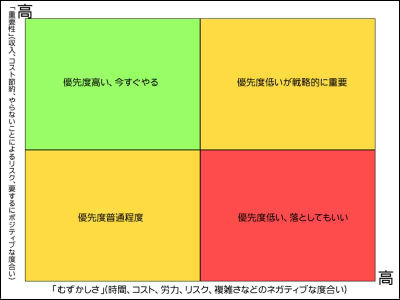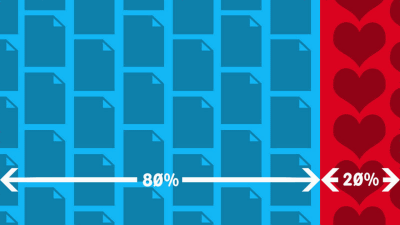A quick and intuitive way to prioritize work

The method introduced here is useful in a wide range of situations, from decision-making at the managerial level to everyday shopping. It's a simple method of drawing a diagram of 4 squares and classifying the work you are currently having in each, but the effect is outstanding.
To begin with, ' intuition ' is the ability to perceive objects and their essence directly based on knowledge without using reasoning. It differs from 'instinct' or 'intuition' in that it is obtained from the experience of living so far. By making full use of this 'intuition', you will be able to quickly determine the priority of your work and process it efficiently, or you will be able to quickly make a decision when you are not sure which product to choose from among multiple products. .
How To Prioritise Quickly And Intuitively | 101 Ways
https://www.101ways.com/2007/06/23/how-to-prioritise-quickly-and-intuitively/
First, draw 4 squares of 2 × 2. Of these, the X-axis and Y-axis represent the following, respectively.
X-axis (horizontal axis): “Difficulty” . A negative measure of time, cost, effort, risk, complexity, etc.
Y-axis (vertical axis): “Importance” . Income, cost savings, risk of not doing it (which is really important), in short, the degree of positivity.
The lower left is the lowest value, and the farther away, the higher the value. It looks like a normal graph.
So, we place the problems and jobs we are currently having in these 4 squares, but the point is to 'relatively' 'compare' the things we place with each other. In other words, A and B are compared to determine which is more difficult or more important. By separating and comparing each one, it will be possible to put it in an appropriate place.
This can also be applied to projects such as product development.
For example, when developing a product, we stand on the side of the final purchaser and owner of that product, and first place it based on the vertical axis, that is, the Y axis only. Standing on the side of the engineer who will ultimately develop the product, place it on the horizontal or X axis only. By doing this, you can easily find out what is required and how difficult it is to achieve it. In this way, the function on the top left is the function that is easy to develop and the function that is required, so it is the function that should be incorporated with the highest priority.
The trick is to place the things that take the least amount of time, effort, and cost, but the most important ones, or vice versa, the extreme ones first. Based on that, relatively judge 'Is it less important or higher than this? Can it be done easily?' And place the rest. Of course, in the middle of placing it, it will become clear that 'No, this seems to be more important', so in such a case let's shift the position of the already placed one.
Don't forget about the one in the top right corner. In short, the jobs that come to this mass are not only 'difficult' but also very difficult, with high 'importance'. This is often the most important strategic point, and if left unchecked, you will not be able to move forward. However, it is just that it is not the top priority and should not be done right now. Conversely, what enters this upper right square determines the fate.
In summary, the priority will be determined as follows.
1. Put things that are easy to do and can be started right away, but are most important in the upper left first
2. Put irrelevant things in the lower right corner that are not easy to do and obviously not important.
3. What will be the relative importance, effort and cost? and place the rest
4. When you have to move what you have placed once, move it
5. When the placement is finally decided, execute in order from the top left.
6. The order to do is upper left → lower left → upper right → lower right . Depending on the case, it may be better not to do the one placed in the lower right, so consider that as well.
7. However, the one in the upper right is something that must be done eventually, and even though it is strategically important, it takes time and effort, so be prepared and do it carefully. going
When you have a mountain of work and you don't know where to start processing it, when you have a lot of things you want and there are various candidates but you don't know which one to buy, you don't know what order to do in product development or a project There is no loss in remembering it because it is useful in all aspects of life, such as situations.
Related Posts:







